Comprehensive Report: Medical Care Practice in Australia
VerifiedAdded on 2022/08/15
|8
|1810
|17
Report
AI Summary
This report provides a detailed analysis of the Australian medical care system. It explores the hybrid model, which combines public and private healthcare structures, and the role of Medicare in providing universal access to medical services. The report outlines the different types of medical facilities available, including primary care, hospital services, and mental health care. It also discusses the financial aspects of the system, including government funding, private insurance, and the responsibilities of various stakeholders such as the government, healthcare professionals, and individuals. Furthermore, the report compares and contrasts the Australian system with the US healthcare system, highlighting similarities and differences in areas such as service delivery, cost, and insurance coverage. The advantages and disadvantages of both systems are also discussed, providing a comprehensive overview of the strengths and weaknesses of each approach. The report concludes by summarizing the key aspects of the Australian medical care system and its effectiveness in providing healthcare services to its citizens.
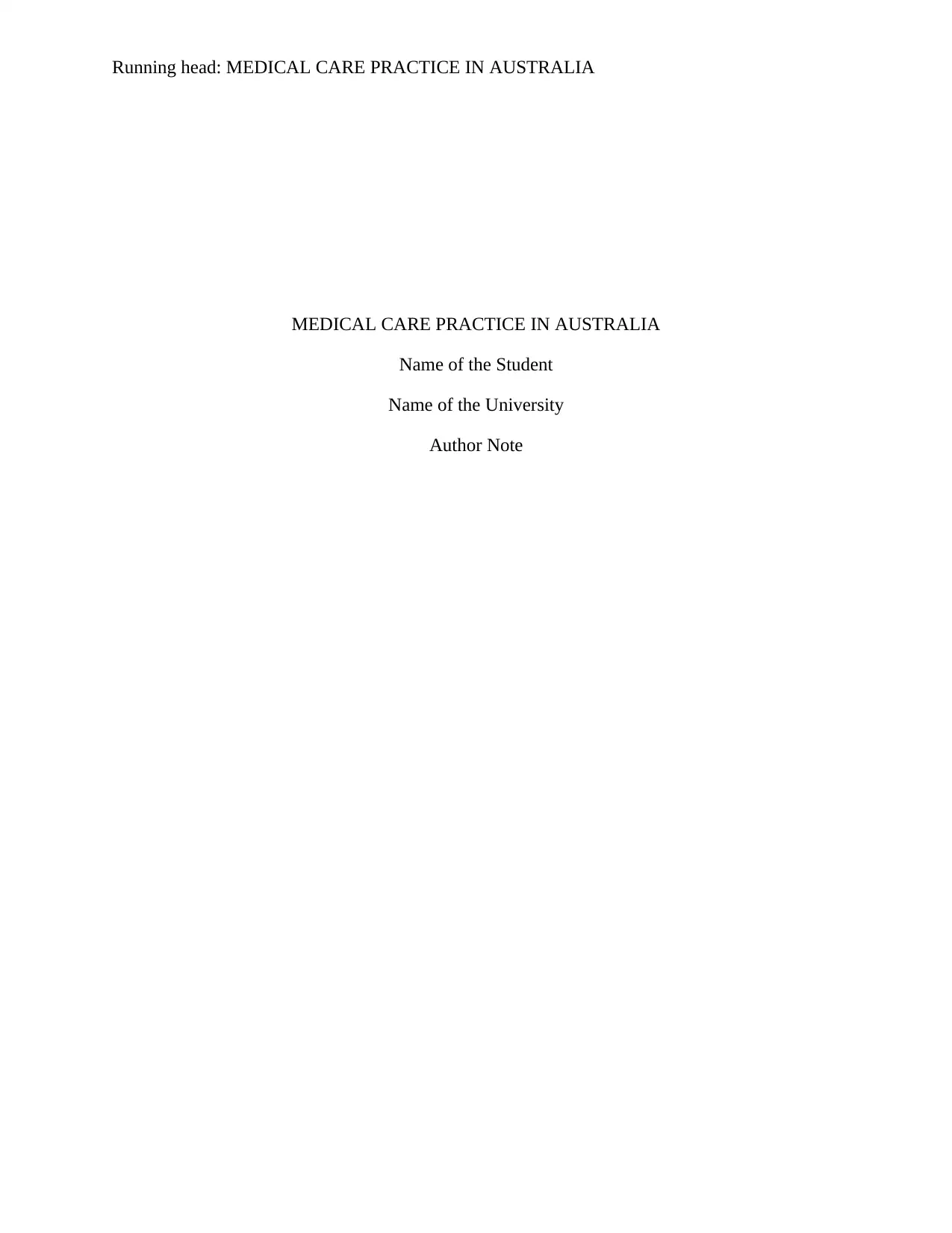
Running head: MEDICAL CARE PRACTICE IN AUSTRALIA
MEDICAL CARE PRACTICE IN AUSTRALIA
Name of the Student
Name of the University
Author Note
MEDICAL CARE PRACTICE IN AUSTRALIA
Name of the Student
Name of the University
Author Note
Paraphrase This Document
Need a fresh take? Get an instant paraphrase of this document with our AI Paraphraser
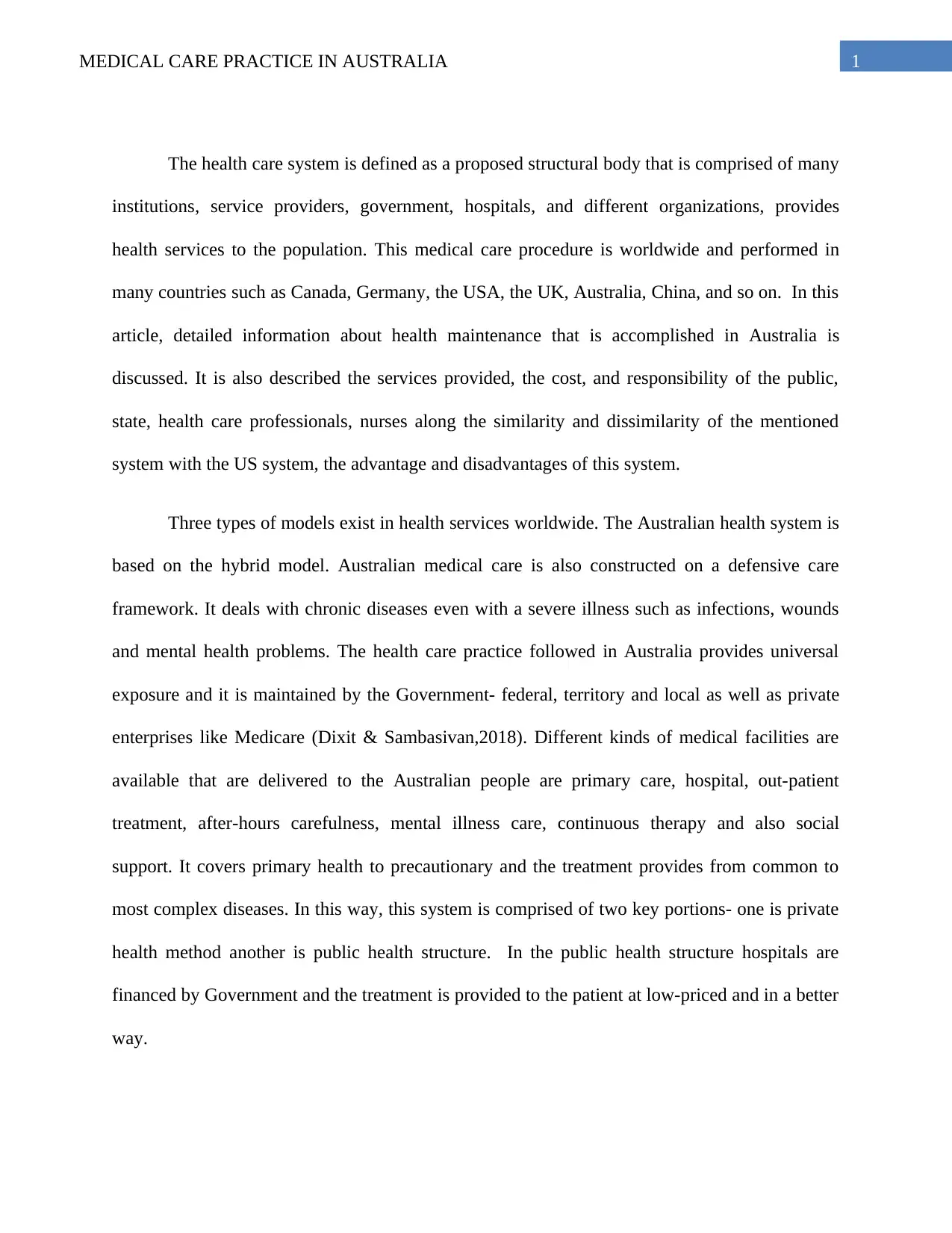
1MEDICAL CARE PRACTICE IN AUSTRALIA
The health care system is defined as a proposed structural body that is comprised of many
institutions, service providers, government, hospitals, and different organizations, provides
health services to the population. This medical care procedure is worldwide and performed in
many countries such as Canada, Germany, the USA, the UK, Australia, China, and so on. In this
article, detailed information about health maintenance that is accomplished in Australia is
discussed. It is also described the services provided, the cost, and responsibility of the public,
state, health care professionals, nurses along the similarity and dissimilarity of the mentioned
system with the US system, the advantage and disadvantages of this system.
Three types of models exist in health services worldwide. The Australian health system is
based on the hybrid model. Australian medical care is also constructed on a defensive care
framework. It deals with chronic diseases even with a severe illness such as infections, wounds
and mental health problems. The health care practice followed in Australia provides universal
exposure and it is maintained by the Government- federal, territory and local as well as private
enterprises like Medicare (Dixit & Sambasivan,2018). Different kinds of medical facilities are
available that are delivered to the Australian people are primary care, hospital, out-patient
treatment, after-hours carefulness, mental illness care, continuous therapy and also social
support. It covers primary health to precautionary and the treatment provides from common to
most complex diseases. In this way, this system is comprised of two key portions- one is private
health method another is public health structure. In the public health structure hospitals are
financed by Government and the treatment is provided to the patient at low-priced and in a better
way.
The health care system is defined as a proposed structural body that is comprised of many
institutions, service providers, government, hospitals, and different organizations, provides
health services to the population. This medical care procedure is worldwide and performed in
many countries such as Canada, Germany, the USA, the UK, Australia, China, and so on. In this
article, detailed information about health maintenance that is accomplished in Australia is
discussed. It is also described the services provided, the cost, and responsibility of the public,
state, health care professionals, nurses along the similarity and dissimilarity of the mentioned
system with the US system, the advantage and disadvantages of this system.
Three types of models exist in health services worldwide. The Australian health system is
based on the hybrid model. Australian medical care is also constructed on a defensive care
framework. It deals with chronic diseases even with a severe illness such as infections, wounds
and mental health problems. The health care practice followed in Australia provides universal
exposure and it is maintained by the Government- federal, territory and local as well as private
enterprises like Medicare (Dixit & Sambasivan,2018). Different kinds of medical facilities are
available that are delivered to the Australian people are primary care, hospital, out-patient
treatment, after-hours carefulness, mental illness care, continuous therapy and also social
support. It covers primary health to precautionary and the treatment provides from common to
most complex diseases. In this way, this system is comprised of two key portions- one is private
health method another is public health structure. In the public health structure hospitals are
financed by Government and the treatment is provided to the patient at low-priced and in a better
way.
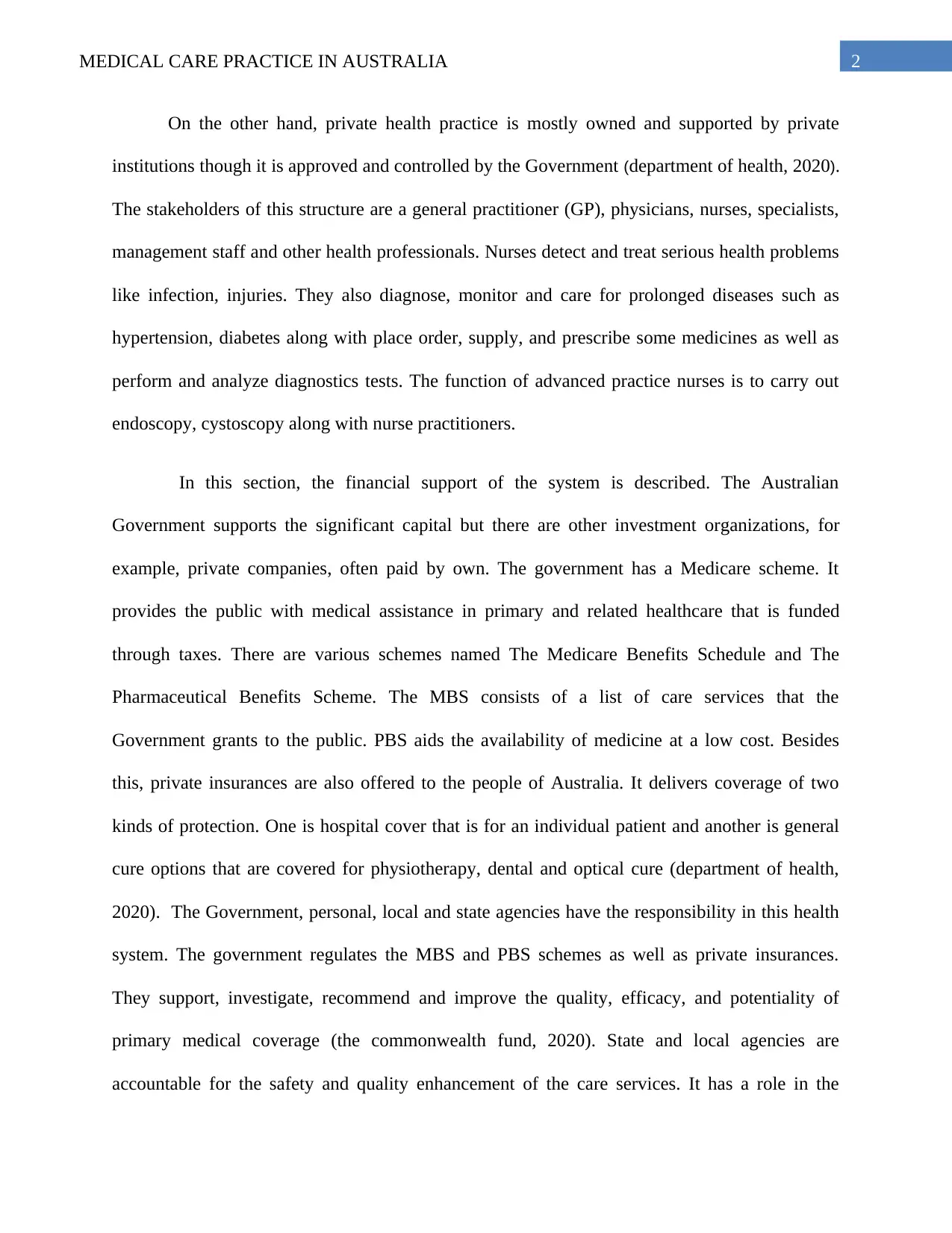
2MEDICAL CARE PRACTICE IN AUSTRALIA
On the other hand, private health practice is mostly owned and supported by private
institutions though it is approved and controlled by the Government (department of health, 2020).
The stakeholders of this structure are a general practitioner (GP), physicians, nurses, specialists,
management staff and other health professionals. Nurses detect and treat serious health problems
like infection, injuries. They also diagnose, monitor and care for prolonged diseases such as
hypertension, diabetes along with place order, supply, and prescribe some medicines as well as
perform and analyze diagnostics tests. The function of advanced practice nurses is to carry out
endoscopy, cystoscopy along with nurse practitioners.
In this section, the financial support of the system is described. The Australian
Government supports the significant capital but there are other investment organizations, for
example, private companies, often paid by own. The government has a Medicare scheme. It
provides the public with medical assistance in primary and related healthcare that is funded
through taxes. There are various schemes named The Medicare Benefits Schedule and The
Pharmaceutical Benefits Scheme. The MBS consists of a list of care services that the
Government grants to the public. PBS aids the availability of medicine at a low cost. Besides
this, private insurances are also offered to the people of Australia. It delivers coverage of two
kinds of protection. One is hospital cover that is for an individual patient and another is general
cure options that are covered for physiotherapy, dental and optical cure (department of health,
2020). The Government, personal, local and state agencies have the responsibility in this health
system. The government regulates the MBS and PBS schemes as well as private insurances.
They support, investigate, recommend and improve the quality, efficacy, and potentiality of
primary medical coverage (the commonwealth fund, 2020). State and local agencies are
accountable for the safety and quality enhancement of the care services. It has a role in the
On the other hand, private health practice is mostly owned and supported by private
institutions though it is approved and controlled by the Government (department of health, 2020).
The stakeholders of this structure are a general practitioner (GP), physicians, nurses, specialists,
management staff and other health professionals. Nurses detect and treat serious health problems
like infection, injuries. They also diagnose, monitor and care for prolonged diseases such as
hypertension, diabetes along with place order, supply, and prescribe some medicines as well as
perform and analyze diagnostics tests. The function of advanced practice nurses is to carry out
endoscopy, cystoscopy along with nurse practitioners.
In this section, the financial support of the system is described. The Australian
Government supports the significant capital but there are other investment organizations, for
example, private companies, often paid by own. The government has a Medicare scheme. It
provides the public with medical assistance in primary and related healthcare that is funded
through taxes. There are various schemes named The Medicare Benefits Schedule and The
Pharmaceutical Benefits Scheme. The MBS consists of a list of care services that the
Government grants to the public. PBS aids the availability of medicine at a low cost. Besides
this, private insurances are also offered to the people of Australia. It delivers coverage of two
kinds of protection. One is hospital cover that is for an individual patient and another is general
cure options that are covered for physiotherapy, dental and optical cure (department of health,
2020). The Government, personal, local and state agencies have the responsibility in this health
system. The government regulates the MBS and PBS schemes as well as private insurances.
They support, investigate, recommend and improve the quality, efficacy, and potentiality of
primary medical coverage (the commonwealth fund, 2020). State and local agencies are
accountable for the safety and quality enhancement of the care services. It has a role in the
⊘ This is a preview!⊘
Do you want full access?
Subscribe today to unlock all pages.

Trusted by 1+ million students worldwide
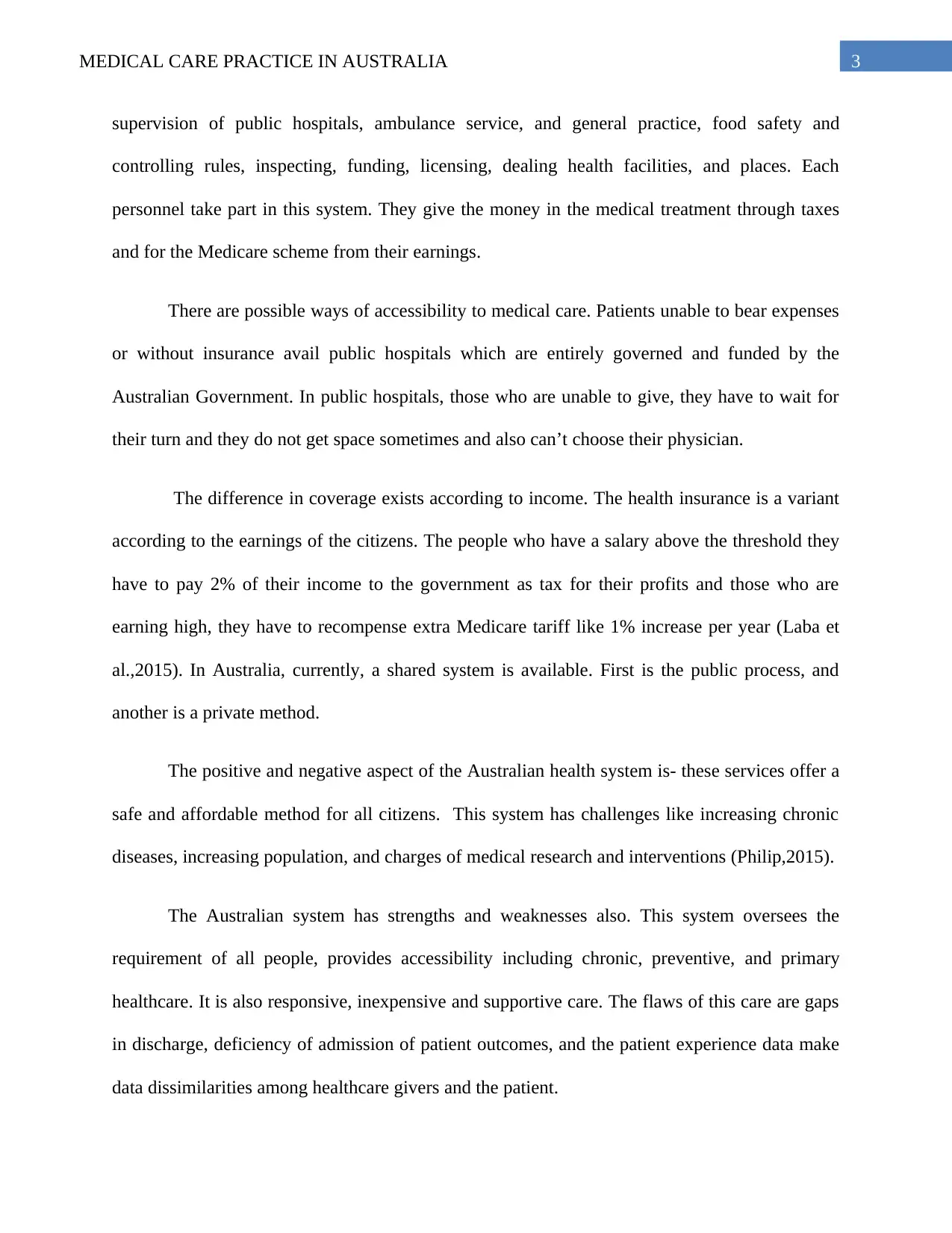
3MEDICAL CARE PRACTICE IN AUSTRALIA
supervision of public hospitals, ambulance service, and general practice, food safety and
controlling rules, inspecting, funding, licensing, dealing health facilities, and places. Each
personnel take part in this system. They give the money in the medical treatment through taxes
and for the Medicare scheme from their earnings.
There are possible ways of accessibility to medical care. Patients unable to bear expenses
or without insurance avail public hospitals which are entirely governed and funded by the
Australian Government. In public hospitals, those who are unable to give, they have to wait for
their turn and they do not get space sometimes and also can’t choose their physician.
The difference in coverage exists according to income. The health insurance is a variant
according to the earnings of the citizens. The people who have a salary above the threshold they
have to pay 2% of their income to the government as tax for their profits and those who are
earning high, they have to recompense extra Medicare tariff like 1% increase per year (Laba et
al.,2015). In Australia, currently, a shared system is available. First is the public process, and
another is a private method.
The positive and negative aspect of the Australian health system is- these services offer a
safe and affordable method for all citizens. This system has challenges like increasing chronic
diseases, increasing population, and charges of medical research and interventions (Philip,2015).
The Australian system has strengths and weaknesses also. This system oversees the
requirement of all people, provides accessibility including chronic, preventive, and primary
healthcare. It is also responsive, inexpensive and supportive care. The flaws of this care are gaps
in discharge, deficiency of admission of patient outcomes, and the patient experience data make
data dissimilarities among healthcare givers and the patient.
supervision of public hospitals, ambulance service, and general practice, food safety and
controlling rules, inspecting, funding, licensing, dealing health facilities, and places. Each
personnel take part in this system. They give the money in the medical treatment through taxes
and for the Medicare scheme from their earnings.
There are possible ways of accessibility to medical care. Patients unable to bear expenses
or without insurance avail public hospitals which are entirely governed and funded by the
Australian Government. In public hospitals, those who are unable to give, they have to wait for
their turn and they do not get space sometimes and also can’t choose their physician.
The difference in coverage exists according to income. The health insurance is a variant
according to the earnings of the citizens. The people who have a salary above the threshold they
have to pay 2% of their income to the government as tax for their profits and those who are
earning high, they have to recompense extra Medicare tariff like 1% increase per year (Laba et
al.,2015). In Australia, currently, a shared system is available. First is the public process, and
another is a private method.
The positive and negative aspect of the Australian health system is- these services offer a
safe and affordable method for all citizens. This system has challenges like increasing chronic
diseases, increasing population, and charges of medical research and interventions (Philip,2015).
The Australian system has strengths and weaknesses also. This system oversees the
requirement of all people, provides accessibility including chronic, preventive, and primary
healthcare. It is also responsive, inexpensive and supportive care. The flaws of this care are gaps
in discharge, deficiency of admission of patient outcomes, and the patient experience data make
data dissimilarities among healthcare givers and the patient.
Paraphrase This Document
Need a fresh take? Get an instant paraphrase of this document with our AI Paraphraser
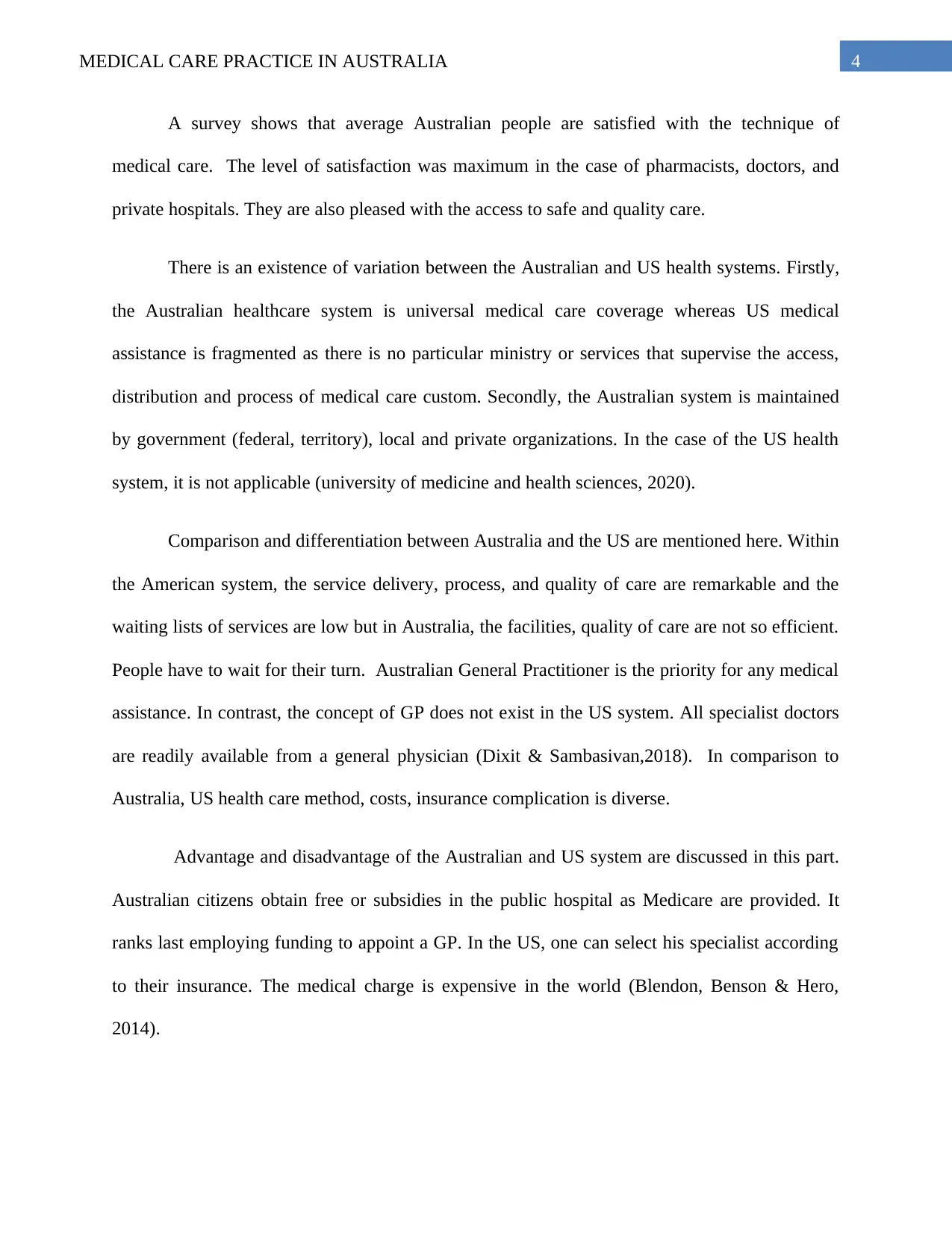
4MEDICAL CARE PRACTICE IN AUSTRALIA
A survey shows that average Australian people are satisfied with the technique of
medical care. The level of satisfaction was maximum in the case of pharmacists, doctors, and
private hospitals. They are also pleased with the access to safe and quality care.
There is an existence of variation between the Australian and US health systems. Firstly,
the Australian healthcare system is universal medical care coverage whereas US medical
assistance is fragmented as there is no particular ministry or services that supervise the access,
distribution and process of medical care custom. Secondly, the Australian system is maintained
by government (federal, territory), local and private organizations. In the case of the US health
system, it is not applicable (university of medicine and health sciences, 2020).
Comparison and differentiation between Australia and the US are mentioned here. Within
the American system, the service delivery, process, and quality of care are remarkable and the
waiting lists of services are low but in Australia, the facilities, quality of care are not so efficient.
People have to wait for their turn. Australian General Practitioner is the priority for any medical
assistance. In contrast, the concept of GP does not exist in the US system. All specialist doctors
are readily available from a general physician (Dixit & Sambasivan,2018). In comparison to
Australia, US health care method, costs, insurance complication is diverse.
Advantage and disadvantage of the Australian and US system are discussed in this part.
Australian citizens obtain free or subsidies in the public hospital as Medicare are provided. It
ranks last employing funding to appoint a GP. In the US, one can select his specialist according
to their insurance. The medical charge is expensive in the world (Blendon, Benson & Hero,
2014).
A survey shows that average Australian people are satisfied with the technique of
medical care. The level of satisfaction was maximum in the case of pharmacists, doctors, and
private hospitals. They are also pleased with the access to safe and quality care.
There is an existence of variation between the Australian and US health systems. Firstly,
the Australian healthcare system is universal medical care coverage whereas US medical
assistance is fragmented as there is no particular ministry or services that supervise the access,
distribution and process of medical care custom. Secondly, the Australian system is maintained
by government (federal, territory), local and private organizations. In the case of the US health
system, it is not applicable (university of medicine and health sciences, 2020).
Comparison and differentiation between Australia and the US are mentioned here. Within
the American system, the service delivery, process, and quality of care are remarkable and the
waiting lists of services are low but in Australia, the facilities, quality of care are not so efficient.
People have to wait for their turn. Australian General Practitioner is the priority for any medical
assistance. In contrast, the concept of GP does not exist in the US system. All specialist doctors
are readily available from a general physician (Dixit & Sambasivan,2018). In comparison to
Australia, US health care method, costs, insurance complication is diverse.
Advantage and disadvantage of the Australian and US system are discussed in this part.
Australian citizens obtain free or subsidies in the public hospital as Medicare are provided. It
ranks last employing funding to appoint a GP. In the US, one can select his specialist according
to their insurance. The medical charge is expensive in the world (Blendon, Benson & Hero,
2014).
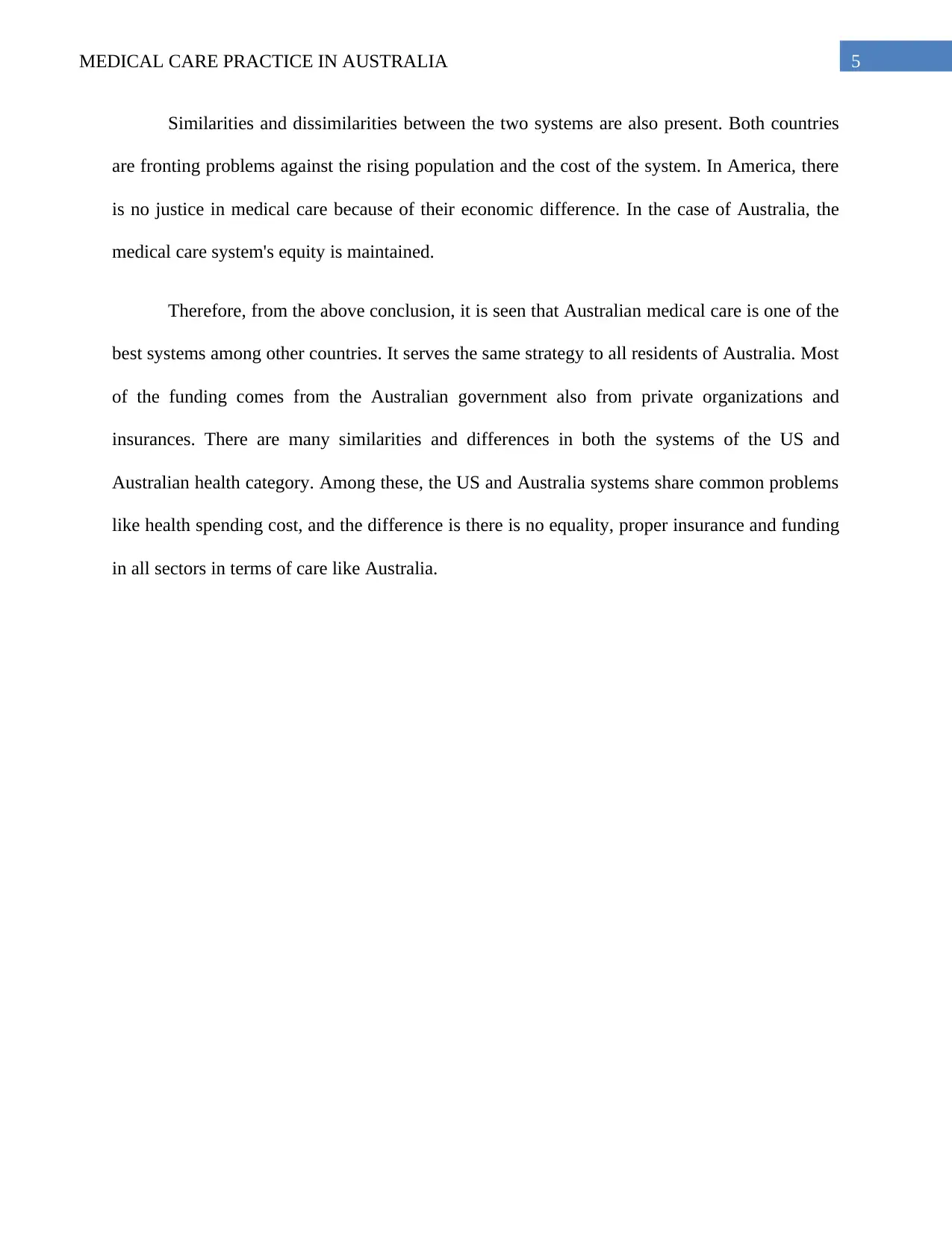
5MEDICAL CARE PRACTICE IN AUSTRALIA
Similarities and dissimilarities between the two systems are also present. Both countries
are fronting problems against the rising population and the cost of the system. In America, there
is no justice in medical care because of their economic difference. In the case of Australia, the
medical care system's equity is maintained.
Therefore, from the above conclusion, it is seen that Australian medical care is one of the
best systems among other countries. It serves the same strategy to all residents of Australia. Most
of the funding comes from the Australian government also from private organizations and
insurances. There are many similarities and differences in both the systems of the US and
Australian health category. Among these, the US and Australia systems share common problems
like health spending cost, and the difference is there is no equality, proper insurance and funding
in all sectors in terms of care like Australia.
Similarities and dissimilarities between the two systems are also present. Both countries
are fronting problems against the rising population and the cost of the system. In America, there
is no justice in medical care because of their economic difference. In the case of Australia, the
medical care system's equity is maintained.
Therefore, from the above conclusion, it is seen that Australian medical care is one of the
best systems among other countries. It serves the same strategy to all residents of Australia. Most
of the funding comes from the Australian government also from private organizations and
insurances. There are many similarities and differences in both the systems of the US and
Australian health category. Among these, the US and Australia systems share common problems
like health spending cost, and the difference is there is no equality, proper insurance and funding
in all sectors in terms of care like Australia.
⊘ This is a preview!⊘
Do you want full access?
Subscribe today to unlock all pages.

Trusted by 1+ million students worldwide
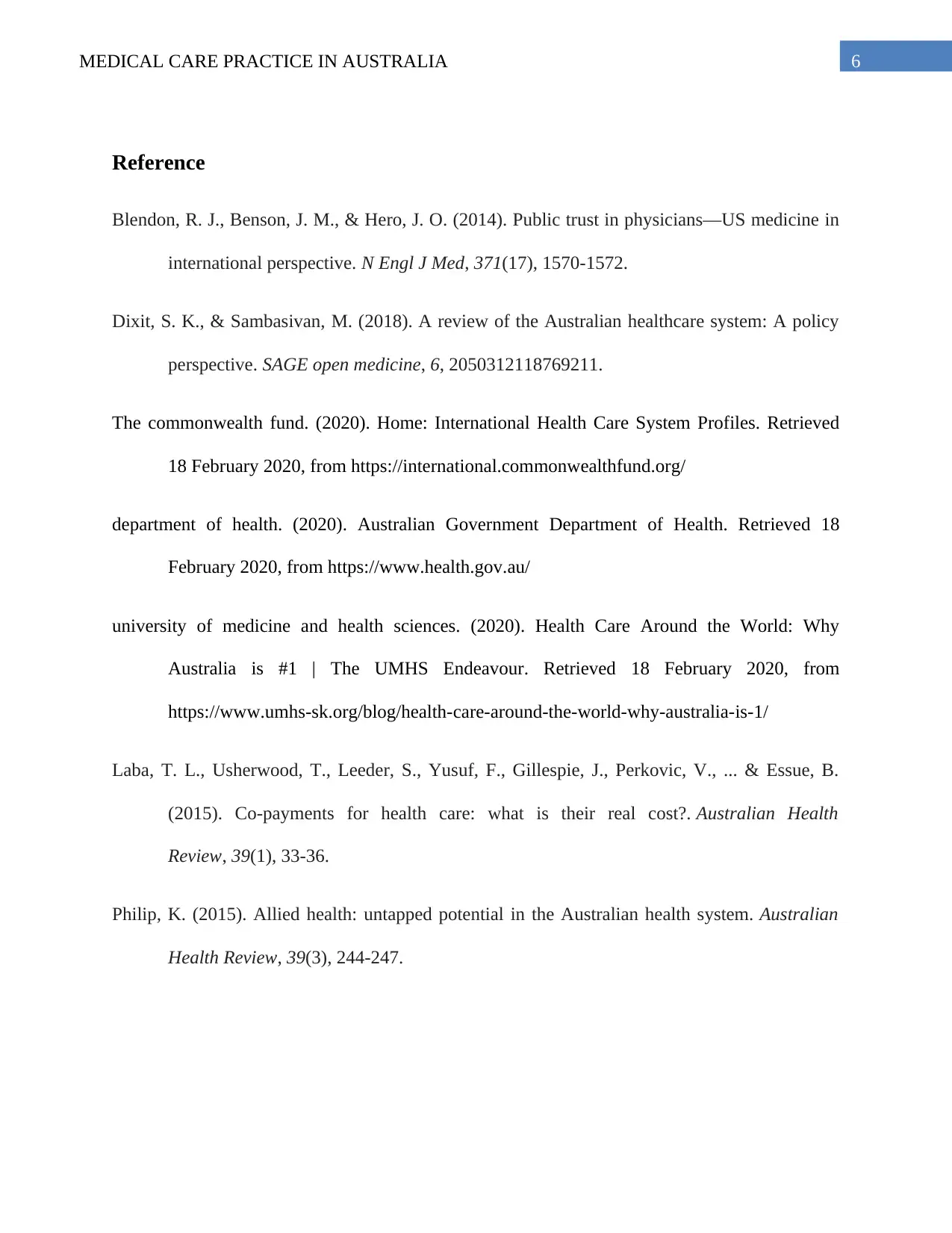
6MEDICAL CARE PRACTICE IN AUSTRALIA
Reference
Blendon, R. J., Benson, J. M., & Hero, J. O. (2014). Public trust in physicians—US medicine in
international perspective. N Engl J Med, 371(17), 1570-1572.
Dixit, S. K., & Sambasivan, M. (2018). A review of the Australian healthcare system: A policy
perspective. SAGE open medicine, 6, 2050312118769211.
The commonwealth fund. (2020). Home: International Health Care System Profiles. Retrieved
18 February 2020, from https://international.commonwealthfund.org/
department of health. (2020). Australian Government Department of Health. Retrieved 18
February 2020, from https://www.health.gov.au/
university of medicine and health sciences. (2020). Health Care Around the World: Why
Australia is #1 | The UMHS Endeavour. Retrieved 18 February 2020, from
https://www.umhs-sk.org/blog/health-care-around-the-world-why-australia-is-1/
Laba, T. L., Usherwood, T., Leeder, S., Yusuf, F., Gillespie, J., Perkovic, V., ... & Essue, B.
(2015). Co-payments for health care: what is their real cost?. Australian Health
Review, 39(1), 33-36.
Philip, K. (2015). Allied health: untapped potential in the Australian health system. Australian
Health Review, 39(3), 244-247.
Reference
Blendon, R. J., Benson, J. M., & Hero, J. O. (2014). Public trust in physicians—US medicine in
international perspective. N Engl J Med, 371(17), 1570-1572.
Dixit, S. K., & Sambasivan, M. (2018). A review of the Australian healthcare system: A policy
perspective. SAGE open medicine, 6, 2050312118769211.
The commonwealth fund. (2020). Home: International Health Care System Profiles. Retrieved
18 February 2020, from https://international.commonwealthfund.org/
department of health. (2020). Australian Government Department of Health. Retrieved 18
February 2020, from https://www.health.gov.au/
university of medicine and health sciences. (2020). Health Care Around the World: Why
Australia is #1 | The UMHS Endeavour. Retrieved 18 February 2020, from
https://www.umhs-sk.org/blog/health-care-around-the-world-why-australia-is-1/
Laba, T. L., Usherwood, T., Leeder, S., Yusuf, F., Gillespie, J., Perkovic, V., ... & Essue, B.
(2015). Co-payments for health care: what is their real cost?. Australian Health
Review, 39(1), 33-36.
Philip, K. (2015). Allied health: untapped potential in the Australian health system. Australian
Health Review, 39(3), 244-247.
Paraphrase This Document
Need a fresh take? Get an instant paraphrase of this document with our AI Paraphraser

7MEDICAL CARE PRACTICE IN AUSTRALIA
1 out of 8
Related Documents
Your All-in-One AI-Powered Toolkit for Academic Success.
+13062052269
info@desklib.com
Available 24*7 on WhatsApp / Email
![[object Object]](/_next/static/media/star-bottom.7253800d.svg)
Unlock your academic potential
Copyright © 2020–2025 A2Z Services. All Rights Reserved. Developed and managed by ZUCOL.





